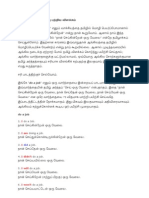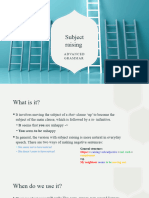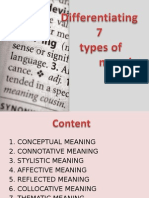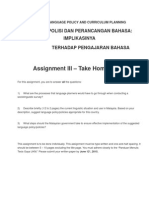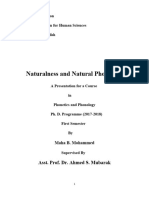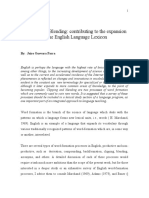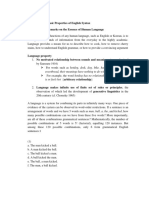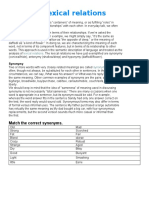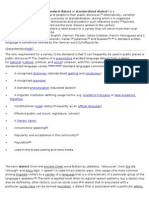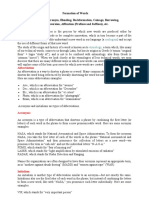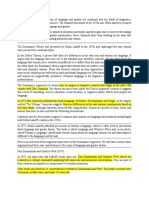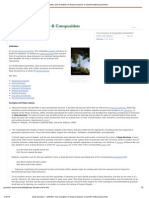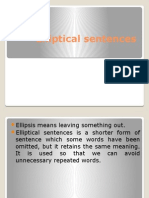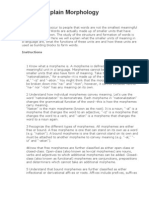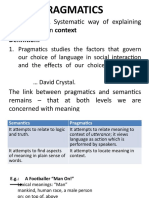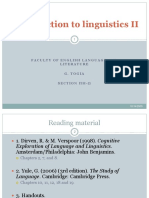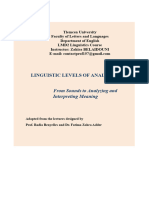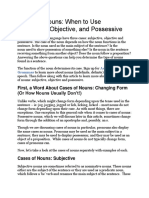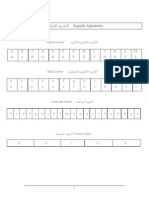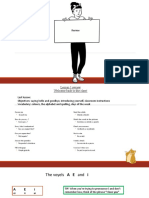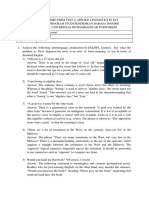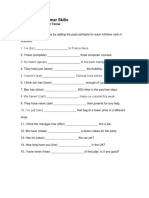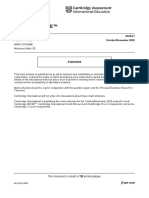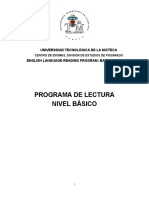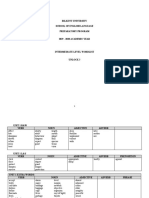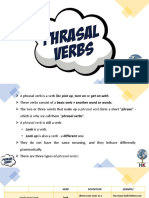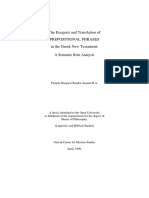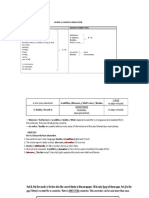100%(1)100% found this document useful (1 vote)
1K viewsCases of Nouns
Cases of Nouns
Uploaded by
junThis document discusses the three cases of nouns in English: subjective, objective, and possessive. Subjective nouns serve as the subject of a sentence or predicate noun following a linking verb. Objective nouns are direct objects, indirect objects, or objects of a preposition. Possessive nouns indicate ownership. While most nouns do not change form based on case, exceptions include possessive nouns which sometimes add an apostrophe or "s". Examples are provided to illustrate each case.
Copyright:
© All Rights Reserved
Available Formats
Download as DOCX, PDF, TXT or read online from Scribd
Cases of Nouns
Cases of Nouns
Uploaded by
jun100%(1)100% found this document useful (1 vote)
1K views4 pagesThis document discusses the three cases of nouns in English: subjective, objective, and possessive. Subjective nouns serve as the subject of a sentence or predicate noun following a linking verb. Objective nouns are direct objects, indirect objects, or objects of a preposition. Possessive nouns indicate ownership. While most nouns do not change form based on case, exceptions include possessive nouns which sometimes add an apostrophe or "s". Examples are provided to illustrate each case.
Original Description:
noun
Copyright
© © All Rights Reserved
Available Formats
DOCX, PDF, TXT or read online from Scribd
Share this document
Read this document in other languages
Did you find this document useful?
Is this content inappropriate?
This document discusses the three cases of nouns in English: subjective, objective, and possessive. Subjective nouns serve as the subject of a sentence or predicate noun following a linking verb. Objective nouns are direct objects, indirect objects, or objects of a preposition. Possessive nouns indicate ownership. While most nouns do not change form based on case, exceptions include possessive nouns which sometimes add an apostrophe or "s". Examples are provided to illustrate each case.
Copyright:
© All Rights Reserved
Available Formats
Download as DOCX, PDF, TXT or read online from Scribd
Download as docx, pdf, or txt
100%(1)100% found this document useful (1 vote)
1K views4 pagesCases of Nouns
Cases of Nouns
Uploaded by
junThis document discusses the three cases of nouns in English: subjective, objective, and possessive. Subjective nouns serve as the subject of a sentence or predicate noun following a linking verb. Objective nouns are direct objects, indirect objects, or objects of a preposition. Possessive nouns indicate ownership. While most nouns do not change form based on case, exceptions include possessive nouns which sometimes add an apostrophe or "s". Examples are provided to illustrate each case.
Copyright:
© All Rights Reserved
Available Formats
Download as DOCX, PDF, TXT or read online from Scribd
Download as docx, pdf, or txt
You are on page 1of 4
Cases of Nouns: When to Use
Subjective, Objective, and Possessive
APRIL 14, 2014 BY KATHY MURDOCK
Nouns in the English language have
three cases: subjective, objective and possessive. The case of the noun
depends on how the noun functions in the sentence. Is the noun used as the
main subject of the sentence? Is the noun used to show possession of
something else? Is the noun in the sentence receiving something from
another object? Does the noun follow a preposition? Answering the above
questions can help you determine the type of nouns found in a sentence.
The function of the noun determines its case. Sign up for Advanced
English Grammar to learn more about nouns (indefinite, definite) or
other parts of speech. Then follow along with this article to learn more
about the three cases of nouns: subjective, objective and possessive.
First, a Word About Cases of Nouns: Changing Form
(Or How Nouns Usually Dont!)
Unlike verbs, which might change form depending upon the tense used in
the sentence ie: jog, jogging, jogged or lick, licking, licked most nouns
do not change form depending upon their case. As with most things, there
are exceptions. One exception to this general rule when it comes to cases of
nouns: Possessive nouns, which we will discuss later in this article,
sometimes change form through the addition of an apostrophe and,
possibly, an s.
Though we are discussing cases of nouns in particular, pronouns also
display the same cases as nouns. Pronouns may be used as the main subject
in a sentence; they may be used to display possession; and they may be
used as an object of a proposition. While cases of nouns do not typically
change form, cases of pronouns can.
Now, lets take a look at the cases of nouns separately with examples of
each.
Cases of Nouns: Subjective
Subjective nouns are sometimes referred to as nominative nouns. These
nouns either are the subject of the sentence or they are used as a predicate
noun, which follows a be verb and renames the main subject of the
sentence. These are likely the easiest nouns to spot, as they are typically the
subject of the verb in the sentence.
Lets take a look at a few examples of subjective/nominative nouns:
Mary drove to the store. Mary is a subjective noun; she is the one that
drove.
Elvis sang for many years. Elvis was the one doing the singing; Elvis is the
subjective noun.
Now, compare those two examples with the following two examples of how
they may be used as a predicate noun:
The teacher was the speaker. The speaker is renaming who the teacher was
and it is linked by was.
Allen is a pediatrician. Pediatrician is the predicate noun as it is renaming
who Allen is and it is linked by the verb is.
Cases of Nouns: Objective
Nouns are referred to as objective when they are used as direct objects,
indirect objects or objects of a preposition. Locating the objective nouns
can be a bit trickier than spotting a subjective or predicate noun, but with a
little practice you will have no trouble identifying these cases of nouns in a
sentence. So lets practice!
Direct Objects: Direct objects receive action in a sentence. They can
typically be found by looking at the verb in the sentence and asking what?
or sometimes whom? As an example:
Show her the book now. (Show whom the book? Her. Her is the direct
object.)
My brother licked a lizard. (Licked what? A lizard. Lizard is the direct
object.)
Indirect Objects: Indirect objects receive the direct object and can be
identified by locating the direct object first and then asking who received
that direct object. Sounds confusing? It wont be after youve had a bit of
practice locating the indirect object. Lets look at a few examples:
Mark threw his father the football. Here, the verb is throw. Throw what?
The football, which is the direct object. Threw the football to whom? He
threw it to his father, which would be the recipient of the direct object (the
football) and, therefore, the indirect object.
Heres another example of an indirect object:
Barbara gave her sister a dollar. To whom did she give the dollar, which is
your direct object? To her sister. So, her sister is the recipient, or the
indirect object, based on the rules above.
Objects of a Preposition: The object of a preposition is the noun or pronoun
that follows a preposition. For example:
He eats with me. With is the preposition, so me is the object of the
preposition.
We used one example above that could have been written by using an object
of the preposition. Look at this:
Mark threw his father the football.
Instead, we could have written:
Mark threw the football to his father. In this instance, due to the use of the
preposition to, father becomes the object of a preposition.
Cases of Nouns: Possessive
Nouns are considered possessive when they are used to show ownership of
something. They will sometimes use an apostrophe, but this is not always
the case. Pronouns can also be used in the possessive case, as in his
backpack or her purse.
Examples of possessive nouns include:
Marys backpack was red. Marys is the possessive noun showing ownership
of the backpack.
Geralds shirt was blue with white stripes. Geralds is the possessive noun.
The course Elementary English Course EFL teaches students about
possessive pronouns.
Cases of Nouns: Getting Your Toes Wet
While we have briefly broken down the different cases of nouns and given
you some examples of each, this lesson is just allowing you to get your toes
wet when it comes to practicing these parts of speech. We did not talk about
a variety of other things, such as predicate adjectives, which describes
nouns; intransitive verbs, which do not have direct objects; or verb
complements. For more advanced lessons in the English language, try
our Intermediate English course.
To practice more usage of nouns, along with verbs and pronouns, sign up
for The Elements of English Grammar, which offers practice sessions
and over 430 minutes of video instruction.
You might also like
- Spoken English To TamilDocument236 pagesSpoken English To TamilRamachandran Ram79% (38)
- Subject RaisingDocument6 pagesSubject RaisingJasmine Cooper100% (2)
- Module 6 Types of PhrasesDocument3 pagesModule 6 Types of PhrasesAsterio Ornopia Asa100% (1)
- Case GrammarDocument14 pagesCase GrammarRhoa Bustos100% (3)
- Cohesion and CoherenceDocument46 pagesCohesion and CoherenceDaphne PerezNo ratings yet
- Bilingualism, Definitions and DistinctionsDocument2 pagesBilingualism, Definitions and DistinctionsEstrella Janirol Humoc PiccioNo ratings yet
- Language, Culture and SocietyDocument17 pagesLanguage, Culture and SocietyCarlynArgentinaPaitanCarduzaNo ratings yet
- Clipping: Examples and ObservationsDocument2 pagesClipping: Examples and ObservationsDani Silva100% (1)
- Ten Aspects of Semantic KnowledgeDocument5 pagesTen Aspects of Semantic KnowledgeISKUNZA GILLNo ratings yet
- English Syntax 2 - Representinf Sentence StructureDocument14 pagesEnglish Syntax 2 - Representinf Sentence StructureArafiqIsmailNo ratings yet
- 7 Types of Meaning - SemanticsDocument19 pages7 Types of Meaning - SemanticsKasia DomagałaNo ratings yet
- Language, Culture and SocietyDocument2 pagesLanguage, Culture and SocietyRod TempraNo ratings yet
- GE6413 Language Policy 3 ASSIGNMENTDocument18 pagesGE6413 Language Policy 3 ASSIGNMENTPrakash Nakaraj100% (1)
- Morphological Processes in Word FormationDocument10 pagesMorphological Processes in Word FormationRahul Narayanan AnupamaNo ratings yet
- Schools of Thought in SLADocument16 pagesSchools of Thought in SLAIli Kamilah0% (1)
- Fundamental Semantic Concepts: SEMANTICS, Fall 2021/2022 Dr. Najib Ismail JaradDocument102 pagesFundamental Semantic Concepts: SEMANTICS, Fall 2021/2022 Dr. Najib Ismail JaradWaad MajidNo ratings yet
- SemanticsDocument36 pagesSemanticsAlfonso Cárdenas PáezNo ratings yet
- Natural PhonologyDocument23 pagesNatural PhonologyAhmed Mubarak100% (1)
- Subject-Verb AgreementDocument26 pagesSubject-Verb AgreementYanitsa DimitrovaNo ratings yet
- Types of PronounsDocument6 pagesTypes of Pronounsnothinginmyway50% (2)
- Department of English: Class: Subject: Discourse Analysis TopicDocument5 pagesDepartment of English: Class: Subject: Discourse Analysis TopicAsad MehmoodNo ratings yet
- Grammar NotesDocument21 pagesGrammar NotesSuriani DaudNo ratings yet
- Clipping and BlendingDocument14 pagesClipping and BlendingJairo GuevaraNo ratings yet
- Some Basic Properties of English Syntax Some Remarks On The Essence of Human LanguageDocument3 pagesSome Basic Properties of English Syntax Some Remarks On The Essence of Human Languagewawan100% (2)
- Phrase Structure RulesDocument12 pagesPhrase Structure RulesNurul AiniNo ratings yet
- Lexical RelationsDocument3 pagesLexical RelationsLízbeth Guillén100% (1)
- Inflection and Derivation PropertiesDocument13 pagesInflection and Derivation Propertiessaif100% (1)
- Standard LanguageDocument11 pagesStandard LanguageAmrita NagNo ratings yet
- Lecture 3 - Word Formation ProcessesDocument8 pagesLecture 3 - Word Formation Processeskhadija seherNo ratings yet
- Object: Definition and ExamplesDocument9 pagesObject: Definition and ExamplesmalexsastryNo ratings yet
- Chapter 13: First Language AcquisitionDocument2 pagesChapter 13: First Language AcquisitionJazz CarbajalNo ratings yet
- Prescriptive GrammarDocument10 pagesPrescriptive GrammarMonette Rivera Villanueva100% (2)
- Dominance TheoryDocument3 pagesDominance TheoryAngel Gutiérrez Tiempo0% (1)
- Derivational & Inflectional MorphologyDocument14 pagesDerivational & Inflectional MorphologyMishell CamachoNo ratings yet
- Cohesion in Discourse Analysis - Group 10Document47 pagesCohesion in Discourse Analysis - Group 10Kim Que Hoang100% (4)
- Truth Conditions SemanticsDocument26 pagesTruth Conditions Semanticsfalak chaudhary0% (2)
- Semantics. SummaryDocument23 pagesSemantics. SummaryLuis ArevaloNo ratings yet
- Sense Relation 9Document22 pagesSense Relation 9Anna ComanNo ratings yet
- Inflectional and DerivationalDocument41 pagesInflectional and Derivationalummi zulaikha bt mohd nor100% (2)
- Deep Structure - Definition and Examples of Deep Structures in Transformational GrammarDocument2 pagesDeep Structure - Definition and Examples of Deep Structures in Transformational GrammarIbnu Shollah Nugraha100% (2)
- Types of NounsDocument5 pagesTypes of NounsnarutothunderjetNo ratings yet
- Definition and Examples of Language VarietiesDocument4 pagesDefinition and Examples of Language VarietiesRizza ArreolaNo ratings yet
- Elliptical SentencesDocument6 pagesElliptical SentencesAlfiannorNo ratings yet
- SemanticsDocument4 pagesSemanticsdanijela_vuković_3100% (2)
- English Proficiency ReviewerDocument4 pagesEnglish Proficiency ReviewerlenNo ratings yet
- Sense RelationsDocument9 pagesSense RelationsLexyyyaNo ratings yet
- Quiz 2 Discourse AnalysisDocument5 pagesQuiz 2 Discourse AnalysisFia eka100% (1)
- MorphemesDocument9 pagesMorphemesJoão SenaNo ratings yet
- Pragmatics PPTDocument19 pagesPragmatics PPTBhava Sharma100% (1)
- Stylistics 1Document48 pagesStylistics 1Chin Chai100% (1)
- PPTDocument31 pagesPPTHaikal Azhari100% (4)
- Levels of AnalysisDocument44 pagesLevels of AnalysisRihamNo ratings yet
- LinguisticsDocument30 pagesLinguisticsSantiago Jr KadusaleNo ratings yet
- AdjectiveDocument4 pagesAdjectiveAlice Del Rosario CabanaNo ratings yet
- Deep and Surface Structure and AmbiguityDocument10 pagesDeep and Surface Structure and AmbiguityTerrence100% (1)
- Types of Literature: Fiction and Non-FictionDocument6 pagesTypes of Literature: Fiction and Non-FictionCoolveticaNo ratings yet
- 212-Allied - III - Literary Forms-Types of Drama - Tragedy and ComedyDocument6 pages212-Allied - III - Literary Forms-Types of Drama - Tragedy and ComedyJ JosephineNo ratings yet
- Some Features of Middle EnglishDocument17 pagesSome Features of Middle Englishesha khan100% (1)
- Victorian PeriodDocument10 pagesVictorian PeriodParlin Pardede100% (1)
- Assignment On NounsDocument14 pagesAssignment On NounsRobert Encila100% (7)
- No Mistakes Grammar Bites, Volume XXVII, “Subject and Verb Agreement” and “Capitalization Rules”From EverandNo Mistakes Grammar Bites, Volume XXVII, “Subject and Verb Agreement” and “Capitalization Rules”No ratings yet
- Cases of NounDocument4 pagesCases of NounZach Matthew GalendezNo ratings yet
- Intermediate B1 Student's BookDocument114 pagesIntermediate B1 Student's BookDunfrey AragãoNo ratings yet
- The Uwu Language: PhonologyDocument18 pagesThe Uwu Language: PhonologyPaulo VictorNo ratings yet
- الأبجدية الإنجليزيةDocument45 pagesالأبجدية الإنجليزيةmohmed4731No ratings yet
- Applied Grammar and UsageDocument28 pagesApplied Grammar and UsageGrace Kunchakara100% (2)
- Part IIDocument97 pagesPart IIsksmailctcNo ratings yet
- Aarts Aarts Ex. UnitsDocument34 pagesAarts Aarts Ex. UnitsLire Lele PereiraNo ratings yet
- Past SimpleDocument7 pagesPast SimpleBerende MonalisaNo ratings yet
- The Passive Voice Explanation Grammar Drills Grammar Guides - 24303Document9 pagesThe Passive Voice Explanation Grammar Drills Grammar Guides - 24303Ваня НиколоваNo ratings yet
- Lesson 2 Online English PowerPoint Presentation Be+ Countries, Nationalities, WH-, Possesive AdjDocument40 pagesLesson 2 Online English PowerPoint Presentation Be+ Countries, Nationalities, WH-, Possesive AdjSmart GradeNo ratings yet
- GA Tieng Anh 10 Global Unit 2 HUMANS AND THE ENVIRONMENTDocument60 pagesGA Tieng Anh 10 Global Unit 2 HUMANS AND THE ENVIRONMENTTrang EmNo ratings yet
- Topics in English SyntaxDocument131 pagesTopics in English SyntaxPro GamerNo ratings yet
- Alfi Ana Lestari (Nim 192120015) - Midterm Test Applied Linguistucs EltDocument5 pagesAlfi Ana Lestari (Nim 192120015) - Midterm Test Applied Linguistucs EltAlfi Ana LestariNo ratings yet
- Present Perfect ActivityDocument6 pagesPresent Perfect ActivityVictorNo ratings yet
- Cambridge IGCSE™: French 0520/41 October/November 2020Document35 pagesCambridge IGCSE™: French 0520/41 October/November 2020DiyaNo ratings yet
- Term I Handbook 7 (24 25)Document203 pagesTerm I Handbook 7 (24 25)24. Xuân QuỳnhNo ratings yet
- Lectura Basico Reading PackDocument62 pagesLectura Basico Reading PackRivaldo SiregarNo ratings yet
- Stative Verbs How To Use Stative (State) and Dynamic VerbsDocument2 pagesStative Verbs How To Use Stative (State) and Dynamic VerbsBondfriendsNo ratings yet
- Unlock 3 Wordlist With Extra Words (UPDATED - September 2018)Document11 pagesUnlock 3 Wordlist With Extra Words (UPDATED - September 2018)Ibrahim Erdem AtilaNo ratings yet
- C2 - Gerund and InfinitiveDocument17 pagesC2 - Gerund and InfinitiveMicaela MontenegroNo ratings yet
- Describing People: Writers Need Certain Skills. in This Chapter, You Will Learn ToDocument33 pagesDescribing People: Writers Need Certain Skills. in This Chapter, You Will Learn ToJefferson GCNo ratings yet
- 3 CATapult Courseware Module 3-VADocument223 pages3 CATapult Courseware Module 3-VALakshit ShahNo ratings yet
- B1 - Phrasal Verbs - Up, On, OffDocument7 pagesB1 - Phrasal Verbs - Up, On, OffAlison Joyce Herrera MaldonadoNo ratings yet
- Chapter 2, 7Cs of Business Communication ADocument28 pagesChapter 2, 7Cs of Business Communication ARameez Ramzan AliNo ratings yet
- Tense and Aspect SystemDocument16 pagesTense and Aspect SystemAisha IdNo ratings yet
- Margret PrepositionsDocument269 pagesMargret PrepositionsSameh SolimanNo ratings yet
- Writing ConnectorsDocument16 pagesWriting ConnectorscellinectnNo ratings yet
- Noun ClausesDocument24 pagesNoun Clausesaria jen05No ratings yet
- Non Finite Verb Forms (-Ing, Infinitive and Past Participle Forms)Document8 pagesNon Finite Verb Forms (-Ing, Infinitive and Past Participle Forms)agustina santillanNo ratings yet
